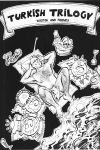The Best We Could Do opens with the complicated, grueling birth of artist Thi Bui’s child in New York City in 2005. Afterward, as Bui lies exhausted in her hospital bed, she realizes the impact of the event: “Family is now something I have created—and not just something I was born into. The responsibility is immense. A wave of empathy for my mother washes over me.”
Much of the subsequent narrative centers on the history of her mother, father, and siblings living in war-torn South Vietnam, then fleeing in 1978 when Bui was three. Though her family survived calamitous events, the emotional scars and cultural confusion they carry as collateral damage are considerable, resulting in gaps in communication and misunderstandings between each generation’s parents and their children. The weight of this history informs the entire narrative, at times foregrounded but always present.


In her early twenties, Bui traveled back to Vietnam to meet her extended family. It was shortly afterward that she began to record the family’s history, hoping that “if I bridged the gap between past and present… I could fill the void between my parents and me.” Her narrative flashes back and forth in time, illustrating how larger events (war, dictatorship, immigration) shaped the family’s lives. She records her father's traumatic, uprooted childhood in the 1950s (she calls him “Bố,” or “daddy”) and how he endured periods of living as a refugee with his abusive, philandering father in a country wracked with sociopolitical turmoil and poverty. Meanwhile, Bui's mother (“Má”) grew up in privilege as a child of a civil engineer, shielded for many years from the dire conditions of much of the country. After marrying Bố, Má gives birth to multiple children, usually under extremely difficult conditions, including her daughter, Bích, right before the Tet Offensive in 1968; a stillborn child, Thảo, in Saigon in 1974; and her son Tâm in a UN refugee camp in Malaysia in 1978.
The sections detailing the history of Vietnam and the war are powerful and painful, offering up a crash course in the history of that long and tragic conflict, from the dark seeds of its origin to its brutal aftermath under an oppressive dictatorship. In one section, Bui describes her parent’s happiness after getting married, living large on two incomes with the future seeming bright—while forces beyond their control are pointing toward large-scale death and destruction. “By this time,” Bui writes ominously, “the chess pieces of the war had been set. It was 1965.” Bui’s narrative voice is admirably straightforward, with an air of a reporter’s detachment, even when describing the most terrible events, infusing her family’s saga with power and grace.
Bui’s family were among the “boat people” who fled oppressive Communist rule after the war ended. But their troubles didn’t stop after arriving in America; along with the general culture shock, they must contend with bitter social and economic downsizing. Bui’s parents’ educational degrees are not recognized in this strange new land, resulting in long hours of minimum wage work and night schooling to better their economic prospects. Bui vividly describes these blighted early years, stuck at home with her father in an apartment in San Diego, while Má is at work and her sisters are at school. She and her little brother Tâm are left alone to cope with Bố's off-putting, distant demeanor, and his scary superstitions and paranoia. None of this made the family’s assimilation any easier.
With the issue of immigration currently hitting full boil stateside, the 2017 publication of The Best We Could Do couldn’t be more timely, or more welcome. Bui’s story movingly puts a human face to new arrivals to our country, illuminating the background of their lives and struggles. Contrary to the rhetoric of the most reactionary U.S. right-wing factions, immigrants are people, not statistics–more than the sum of their homelands, more than the color of their skin. Bui depicts, with unsparing candor, the multiple traumas associated with being forced out of one’s country into the unknown.

In her introduction, Bui describes the frustration she felt with her original plan of telling her family's story—a combination of text with some photographs and art: “I didn't feel like I had solved the storytelling problem of how to present history in a way that is human and relatable and not oversimplified. I thought turning it into a graphic novel might help.” She teams her brushy line with a burnt orange wash that lends an evocative, melancholic feel; even in the present-day scenes there is a sense of the past hovering, seeping into ordinary life. While Bui has self-deprecatingly referred to herself online as “the slowest cartoonist in America,” she is skilled at page layouts, delivering information deftly and imaginatively. As with her text, she accomplishes this without any undue fuss or “look-at-me” graphic pyrotechnics.
At the narrative’s end, Bui focuses on her now ten-year-old son, wondering if the pain she inherited from being a “product of war” will be transmitted to him: “whether I would pass along some gene for sorrow or unintentionally inflict damage I could never undo.” But she reminds us that life is, at heart, random, and that relationships are not necessarily bound by destiny but by free will and a dizzying array of events, most beyond our control. This final summation is deeply moving. Thematically rich and complex, melding together grief and hope, the personal and the political, the familial and the national, The Best We Could Do is an important, wise, and loving book.







